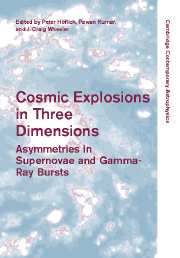42 - Three-dimensional explosions
Published online by Cambridge University Press: 11 August 2009
Summary
Introduction
This conference was packed with interesting and relevant developments regarding the three-dimensional nature of both thermonuclear and core-collapse supernovae. Before summarizing those presentations, I would like to summarize some of the developments regarding rotation and magnetic fields that were on my mind during the conference.
Dynamo theory and saturation fields
There has been a major breakthrough in the conceptual understanding of astrophysical dynamos in the last few years. In traditional mean field dynamo theory, the turbulent velocity field that drives the “alpha” portion of the α – Ω dynamo was specified and held fixed. A weakness of the original theory was that the turbulent velocity field cannot be constant. The buildup of small scale magnetic field tends to inhibit turbulence, cutting off the dynamo process for both small and large scale fields. Since the small scale field tended to grow faster than the large scale field, it appeared that the growth of the large scale field would be suppressed (Kulsrud & Anderson 1992; Gruzinov & Diamond 1994). In these theories, the magnetic field energy cascades to smaller length scales where it is ultimately dissipated at the resistive scale. Large scale fields tend to build up slowly, if at all.
The solution to this problem has been the recognition (Blackman & Field 2000; Vishniac & Cho 2001; Field & Blackman 2002; Blackman & Brandenburg, 2002; Blackman & Field 2002; Kleeorin et al. 2002) that the magnetic helicity, H = A · B is conserved in ideal MHD and that this conservation had not been treated explicitly in mean field dynamo theory.
- Type
- Chapter
- Information
- Cosmic Explosions in Three DimensionsAsymmetries in Supernovae and Gamma-Ray Bursts, pp. 373 - 383Publisher: Cambridge University PressPrint publication year: 2004

